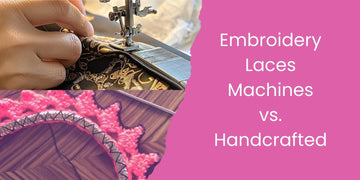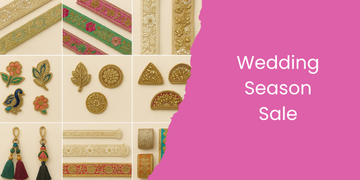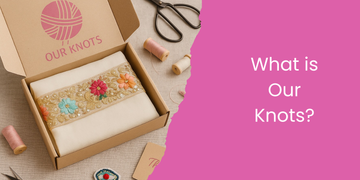In the world of fashion, home textiles, and couture, lace embroidery is a detail that adds elegance, sophistication, and artistic value. Whether it's a bridal gown adorned with delicate embroidered lace or a designer saree trimmed with fine embroidered trims, these intricate designs elevate the final product to a work of art.
But behind these beautiful creations lies a decision for designers and manufacturers: Should lace embroidery be done by machines or by hand? With both methods offering unique benefits and drawbacks, it’s important to understand their differences — especially in a market that values both automation and craftsmanship.
This blog explores the pros and cons of machine embroidery versus handcrafted lace embroidery and provides insights into current market trends shaping the industry.
What Is Lace Embroidery?
Lace embroidery is the art of creating decorative patterns using thread stitched onto fabric, often in openwork styles. This technique enhances garments, draperies, accessories, and upholstery with intricate beauty.
Two popular categories in this domain are:
- Embroidered Lace: Typically used for bridal wear, gowns, veils, and high-end garments.
- Embroidered Trims: Narrow lace patterns stitched on the edges of garments, cushions, or curtains, used as decorative borders.
Embroidery can be done in two primary ways:
- By machine, using computer-aided designs (CAD) and industrial embroidery equipment.
- By hand, through skilled craftsmanship and manual needlework.
Machine Embroidery: Fast, Scalable, and Efficient
Advantages of Lace Embroidery Machines
-
Speed & Scalability
Machine embroidery can produce meters of embroidered trims in minutes. It's ideal for bulk production where time is a constraint. -
Consistency & Precision
Thanks to digitized patterns, machines ensure uniform designs throughout large batches — reducing human errors and variations. -
Cost-Effectiveness for Mass Production
Once the design is set, machine embroidery becomes significantly cheaper per unit, especially when producing large volumes. -
Versatility in Design
Advanced software allows users to create intricate, complex patterns that are replicated exactly. This is useful for brands needing uniformity in collections. -
Minimal Waste
The precision of machines means less fabric and thread waste, which is ideal for reducing material costs.
Disadvantages of Machine Embroidery
-
Initial Investment
Buying and setting up embroidery machines can be expensive, especially for smaller businesses or independent designers. -
Lack of Artisan Feel
Machine work can lack the organic charm, emotion, and uniqueness that hand embroidery offers. This is especially important in haute couture. -
Limited Adaptability
If a client requests a minor change to a machine design, the entire digital file may need editing, which requires technical knowledge and time.
Handcrafted Lace Embroidery: Heritage, Elegance, and Detail
Advantages of Hand Embroidery
-
Artistic Value
Each handcrafted embroidered lace piece is a unique representation of the artisan’s skill and creativity — no two pieces are exactly alike. -
Cultural Richness
Many regions have traditional embroidery techniques (like Zardozi, Chikankari, or French lacework) that can only be created by hand, preserving heritage. -
Flexible Design Execution
Artisans can adjust designs on the go, respond to design nuances, and apply a variety of threads, beads, or textures seamlessly. -
Premium Appeal
Hand-stitched embroidered trims are seen as luxurious and exclusive, often used in high-end designer garments, wedding dresses, and runway collections.
Disadvantages of Hand Embroidery
-
Time Intensive
Completing a few meters of lace can take days or even weeks. This makes it unsuitable for fast fashion or bulk orders. -
Costly Labor
Skilled hand embroidery requires fair compensation. The labor cost drives up the price, making it impractical for low-budget production. -
Inconsistencies
Since each artisan works manually, slight variations may occur between products — which can be both a charm and a challenge depending on the project.
| Feature | Machine Embroidery | Hand Embroidery |
|---|---|---|
| Production Speed | ✅ Fast | ❌ Slow |
| Cost per Unit | ✅ Low (for large batches) | ❌ High |
| Uniqueness | ❌ Identical patterns | ✅ Each piece is unique |
| Skill Requirement | ✅ Easy after setup | ❌ High-level artisan skill needed |
| Artistic Detailing | ❌ Somewhat limited | ✅ Highly detailed and intricate |
| Environmental Impact | ✅ Controlled material usage | ❌ Can lead to more waste (time/resources) |
| Suitable For | Mass production, retail | Luxury wear, bridal, haute couture |
Market Trends in Lace Embroidery
1. Hybrid Design Approach
Many fashion houses now blend both methods: Machines create the base, and hand embroidery finishes the details. This helps maintain scalability while offering a premium touch.
2. Increased Demand for Ethical Products
Consumers are increasingly valuing handcrafted embroidered lace created by local artisans under ethical working conditions. This is influencing purchasing decisions, especially in luxury segments.
3. Digital Customization for Machines
With improvements in CAD and AI, machine embroidery is becoming more customizable, allowing semi-personalized products to be produced at scale — a trend gaining traction in retail.
4. Support for Artisan Communities
Governments and NGOs are supporting local artisan communities that create hand-embroidered trims to preserve culture and create employment, particularly in countries like India, Bangladesh, and Italy.
5. Eco-Friendly Materials in Focus
There’s also a shift toward using sustainable threads and organic fabrics in both hand and machine embroidery, aligning with the green fashion movement.
Use Cases: Where Each Method Shines
Machine-Made Embroidered Lace
- School uniforms
- Mass-market home textiles
- Ready-to-wear garments
- Decorative trims for bulk items
Handcrafted Embroidered Trims
- Wedding & bridal wear
- Couture fashion lines
- High-end sarees and lehengas
- Traditional costumes and museum replicas
Final Thoughts: Which One Is Right for You?
Choosing between machine-made and hand-embroidered lace depends entirely on your brand’s goals:
- If you're a manufacturer looking for fast delivery, cost efficiency, and consistent output, machine embroidery is the clear winner.
- If you're a designer or boutique brand looking to offer limited-edition, artistic pieces with heritage and luxury appeal, hand embroidery is the better choice.
However, the most powerful approach today may lie in combining the two — automating base layers while adding hand-finished touches to deliver both scale and soul.
Looking to Source High-Quality Embroidered Lace or Trims?
Whether you're seeking machine-embroidered trims for large-scale garment production or handcrafted lace for a luxury collection, make sure to work with experienced suppliers like Our Knotswho prioritize both craftsmanship and quality.
For the latest trends, tips, and sourcing solutions in lace embroidery, stay tuned to our blog — where tradition meets innovation.






